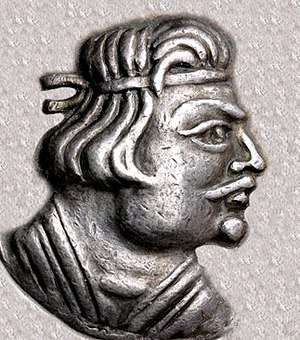Heraios
| Heriaos | |
|---|---|
| Kushan ruler | |
 Portrait of Heraios. | |
| Reign | 1–30 CE |
| Predecessor | Sapadbizes |
| Successor | Kujula Kadphises |

Obv: Bust of Heraios, with Greek royal headband.
Rev: Horse-mounted King, crowned with a wreath by the Greek goddess of victory Nike. Greek legend: ΤΥΡΑΝΝΟΥΟΤΟΣ ΗΛΟΥ - ΣΑΝΑΒ - ΚΟϷϷΑΝΟΥ "The Tyrant Heraios, Sanav (meaning unknown), of the Kushans".

Obv: Bust of Heraios, with Greek royal headband.
Rev: Horse-mounted King, crowned with a wreath by the Greek goddess of victory Nike. Greek legend: ΤΥΡΑΝΝΟΥΟΤΟΣ ΗΛΟΥ - ΣΑΝΑΒ - ΚΟϷϷΑΝΟΥ "The Tyrant Heraios, Sanav (meaning unknown), of the Kushans".


Heraios (often read as Heraus, Heraos, Miaos) was a clan chief of the Kushans (reign: 1-30 CE), one of the five constituent tribes of the Yuezhi confederacy in Bactria in the early 1st century CE, roughly at the time when the Kushans were starting their invasion of India.[1] After close analysis of several Heraios coins, Joe Cribb of the British Museum has suggested that these belong to Kujula Kadphises, and, unlike Kujula's other coins, which have portraits of the Greek King Hermaios, the "Heraios" coins depict Kujula himself.[2]
Silver coins were made in the Hellenistic style and used the Greek script. The reverse shows the winged Greek god of victory Nike holding out a wreath over the clan chief mounted on a horse. The clan chief wears a tunic and has a large bow on the side. The portrait shows Heraios with a marked artificial skull deformation, a characteristic of several Kushan portraits and sculptures of the 1st century CE.
On the coins, the clan chief's name appears as "ΗΛΟΥ" or ""ΗΙΛΟΥ", which has been variously transliterated as "Ilou", "Maou" or "Miaou".
| Preceded by Sapadbizes (as ruler in Bactria, Yuezhi) |
Kushan Ruler 1 – 30 CE |
Succeeded by Kujula Kadphises |
References
- ↑ Ancient Coin Collecting VI: Non-Classical Cultures p.92 Wayne G. Sayles F+W Media, Inc, 1999
- ↑ Cribb, Joe (1993). The Heraus Coins: Their Attribution to the Kushan King Kujula Kadphises, c. AD 30-80 (PDF). Essays in Honour of Robert Carson and Kenneth Jenkins. London: Spink. pp. 116–140. Retrieved 2018-03-08.